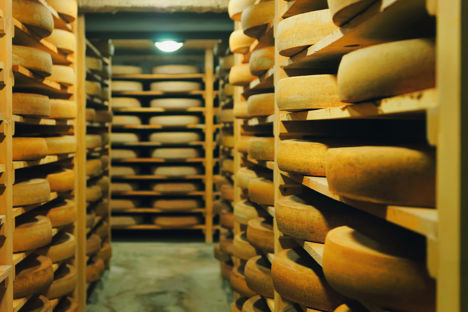
Comté cheese: a French treasure
Comté is one of the world's most popular cheeses, but it has an incredible heritage to match. We take a look at the little details that make this raw milk cheese such a treasure.
Comté cheese: a French treasure
Comté is one of the world's most popular cheeses, but it has an incredible heritage to match. We take a look at the little details that make this raw milk cheese such a treasure.
There's gold in the lush, rolling hills of eastern France. For over a thousand years, farming communities in the Jura Massif region have sought to preserve their milk for the months ahead by crafting it into Comté – a sweet, nutty cheese with almost unmatched depths of flavour. The lush, verdant pastures here provide ample grazing for large herds of Montbéliarde and French Simmental cattle who roam the hills freely in the summer months. Jura Massif is home to an incredibly diverse range of flora and that contributes a great deal to what will eventually become one of the great cheeses of the world.
Comté has always been a co-operative, largely because of the labour and quantities of raw product involved in the process. It can take 500 litres of milk to make a single forty-kilogram wheel of cheese, which means multiple small-scale farmers must band together. From start to finish this is a story of rural collaboration, Comté journeys through the hands of three groups of artisans – dairy farmers, fromagers (cheesemakers) and affineurs (those who age and refine the cheese) – before it arrives on your plate.
Comté fromagers will only work with milk taken from within an eight-mile radius of their fruitière – the cheese production facility that transforms the ‘fruit of the farm’ – in order to preserve the local character of the cheeses. There are currently around 150 fruitières making cheese in the region, and they all use centuries-old traditional methods to make their cheese – part-skimming the milk, curdling in copper vats, then pressing the fresh cheeses to prepare them for their affinage.
The final stage in the craft of this remarkable cheese is its maturation, taking place in dark, damp caves where young cheeses are rested, brushed, turned and loved by the region’s affineurs. There are only sixteen of these cellars in the Jura Massif, but between them they store the one and a half million wheels of cheese that are produced every year. This is where the unique flavours, colours and textures of the cheeses are coaxed out, aged at least four months and up to several years, with each affineur working with environment, experience and individual style to get the very best out of each wheel.
Most cheeses today are made with pasteurised milk, where the milk is heat-treated to kill off all bacteria. Comté, on the other hand, is a raw milk cheese. The milk is only heated gently, so natural bacteria – responsible for so much flavour and complexity – are retained, developed and celebrated by the cheesemaker. Working with raw milk requires incredible skill and expertise – if handled incorrectly, you risk allowing bad bacteria into the process and ruining the cheese. As such, the use of raw milk is the ultimate sign of high-quality craftsmanship.
Go back far enough, before the discovery of pasteurisation, and all cheeses would have been made with raw milk. This process celebrates the very origin of cheese-making, but it also preserves the unique, distinct qualities of the terroir of Jura Massif, giving Comté its most appealing characteristics.
Cattle in the hills of eastern France have a huge amount of space to roam in. In the warmer months they graze outside on 576 different species of grass, flowers and other unique flora, and in the harsh winters, the cows come inside to feed on hay. As a result, the flavour of Comté changes distinctly over the course of a year, reflecting the seasons as well as individual farms that surround the fruitière. These distinctions are important for the cheese lover, but the appreciation of these nuances also means conservation and biodiversity remain highly prized in the region.
Anywhere for four to twenty-four months can be spent aging a wheel of Comté, over which time the cheese evolves greatly. Aged Comté is often favoured over younger Comté – there is a misperception that older cheese is better, but in truth, a youthful Comté can be just as complex as an aged one. Young Comté tends towards fresh, lactic flavours of butter and yoghurt with sweet caramel notes and hints of fresh fruit, while longer-aged cheeses yield spicier, nuttier, more intense umami flavours – think brown butter, toasted nuts, fruity citrus and raw sugar. The time of year the cheese is produced is also strongly reflected in the cheese – summer milk yields golden cheeses with richer, earthier flavours, while winter milks produce more delicate, milky wheels.
It’s not only the flavour that evolves over time. The cheese itself becomes harder, grainier and more crumbly. Amino acid crystals – often mistaken for salt crystals – form inside, providing little pockets of texture against the cheese.
It's said that eighty-three separate flavour compounds can be detected in Comté. Where standardisation and tedious uniformity are the watchwords of factory production, Comté is one of those rare cheeses that places seasonality and regional distinction at the heart of its processes. Certainly something to shout about from the rolling, green hills.


